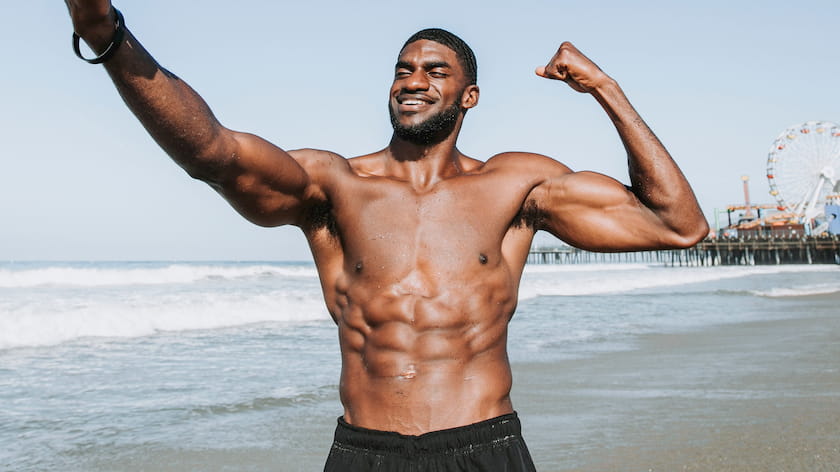The foundation of creating a training routine is vital to the success of anyone who plans on building an impressive amount of strength and muscular size. This article is going to teach you how to do this using the unique type of training called powerbuilding.
Powerbuilding is becoming a prominent way of training for many gym-goers because it gives you the best of both worlds in terms of bodybuilding and powerlifting.
Best of all, powerbuilding is simple to follow and will help you make consistent progress week-in and week-out. Give this blog a read and get ready for some gains!
Constant Progression Is Key
Progression is ultimately what drives muscle tissue to grow. If you’re not constantly challenging your body with higher weight, more volume, and other intensity techniques, there’s simply no reason for your muscles to grow.
However, it gets a little trickier for intermediate and advanced trainees than just simply adding weight to the bar because, as you progress, progress gets tougher.
Basically, you need to employ other tactics to keep progressing. This can include things like slower rep cadences (to increase time under tension), using bands and chains, drop sets, rest-pause sets, and forced reps.

In the grand scheme of things, it doesn’t make much sense to train if you’re not trying to improve your capabilities. Who wants to put in hours upon hours of effort into their gym routine just to remain the same? Not us, and hopefully not you.
Just think about the last time you saw a massive guy in the gym who wasn’t able to move some impressive amount of weights? Or the last time you saw a scrawny kid benching 405lbs? Odds are it’s a rare sighting.
This is why powerbuilding makes the most sense in the long run.
Explaining the Variables of Training
The concepts found below are necessary to understand how to create an optimal training routine:
- Volume = Sets x Reps
- Research demonstrates training volume, not intensity, is what dictates the muscle protein synthetic response in response to training (assuming each exercise is taken to failure or near failure)
- Intensity is how much weight you’re using in comparison to your one-rep maximum, with heavier weights being more intense
- Frequency is how many times you train a muscle or muscle group in a given timeframe
- Time under tension is the time a muscle is spent under a load of weight

Powerbuilding = Powerlifting + Bodybuilding
Powerlifting and resistance training for pure strength is mainly neurological. In simpler terms, being able to lift your absolute max for one repetition requires different motor recruitment patterns than lifting a lighter weight.
Moreover, force output revolves your capacity to recruit motor units. When you activate a motor unit, a rush of chemical events cause the linked muscle fibers to forcefully contract. Therefore, the more you practice heavy resistance training, the more adapted your neuromuscular system will be.
Bodybuilding, on the contrary, is mainly about placing as much stress on target muscles as possible. This is simply done by using sufficient weight and volume, repeatedly.
So in many ways, bodybuilding is kind of a brainless process, since all you really need to do is use a modest amount of weight and move it around time and time again.
Obviously, bodybuilders aren’t immediately concerned about being strong. However, if you increase your strength, you ultimately create a greater potential to grow in the long run. Otherwise, you will be stuck lifting the same weights, and your body won’t have much reason to grow.
Nevertheless, prioritizing heavy resistance training can hinder hypertrophy training due to the large amounts of stress it places on the nervous system.

Multiple Rep Ranges for Elite Results
As noted earlier, training volume is the main factor for muscle growth. Yet, training your neuromuscular system with heavy weights and low reps is necessary to increase strength.
So, you must incorporate multiple workouts each week that focus on differing intensities and rep ranges for optimal progress.
This is the beauty of powerbuilding because it does just that.

Powerbuilding Training Frequency
Traditional bodybuilding wisdom will have you believe that you should train each muscle once a week with loads of volume. However, this is far from efficient.
After an intense training session, muscle protein synthesis increases for upwards of three days and then returns to baseline values.
Basically, if you only train each group once per week, you’re greatly hurting your growth potential. It’s comparable to only eating one massive meal per day and then fasting the rest of the day. It might “work” for a while, but you could be getting so much more out of your diet. Training is no different.
Keep in mind that size and strength are far from mutually exclusive. If anything, size and strength go hand-in-hand. Powerbuilding supports that principle by allowing you to dedicate days each week to building strength and size.
Powerbuilding Training Split Explained

Training splits are your structure for the week and will dictate exactly how you plan out your sessions. Some people may tell you they have a 5-day split, training a single muscle group only once per week. That means they train five days in a calendar week; usually, each session targets one muscle group (which is a generally inferior way of setting up your training).
If you want slow results, train like the example above. Unfortunately, that’s the way the majority of people train. As a beginner, you’ll get results with almost anything you do; but as a novice or regular gym goer, you can start mixing it up. At Jacked Factory, we do things differently.
Powerbuilding training splits focus on training each muscle group at least twice per week. More frequency is ideal for novices as there is still plenty of room for growth and improvement.
Our recommended powerbuilding split involves five weight training sessions per week. You may be asking why not six or seven? Put simply, more is not always better.
This training routine is split into two power days and three hypertrophy days. This will ensure your entire muscular system gets enough volume, intensity, and frequency throughout the week. It also ensures you will have enough recovery time; that’s where the magic of muscle growth happens.
Power Days Explained
Both Monday and Tuesday are heavy days, which will focus mostly on a rep range of 8 or less. Your focus on these days is lifting heavy, but never to failure.
You should not sacrifice performance or intensity across these days just to train to failure. Keep your performance levels and recovery high. These are high performance and high skill days, not days to obliterate yourself.
- Warming Up: It’s important to prevent injuries on power days by warming up your muscles and nervous system. It is best to perform 2-3 light sets on your first exercise by slowly incrementing the weight up to the working weight you will be using for the first “true” set. This will give your body the chance to prepare itself for moving some heavy weights. Yea buddy!
- Picking Your Weights: Pick an approximate weight for each set that you can perform the number of repetitions required while still leaving 1-2 repetitions “in the tank.” Write down weights used and aim to add 5-10% more weight to each set or 1-2 extra repetitions on the weight used previously. You should be progressing week-to-week.
- Rest: On heavy days, rest as long as required to keep your strength high. 3-5 minutes between heavy sets should be plenty of time for your central nervous system (CNS) to recover.

Hypertrophy Days Explained
After a good rest on Wednesday, you will dedicate Thursday, Friday, and Saturday to using lower intensity but increasing your volume! So in other words, lighter weights but you lift them a whole lot more!
- Warming Up: The same principles apply as on heavy days; make sure you get some blood flowing and joints warmed up for the volume ahead. One training day won’t make you, but it can break you. So take your time getting the blood flowing; an injury is the last thing we want to deal with at this point
- Picking Your Weights: For the light days, leave a few more in the tank. Pick a weight where you can complete the repetitions required with 3-4 hard repetitions left in the tank. We want you lifting more weight, for as many times as you can throughout these days. Destroying your muscles early on won’t help keep your volume high. More advanced lifts can be used later when progress stalls and you are ready to upgrade to a hardened-level program.
- Rest: The lighter weights will be more taxing on your actual muscles and the cardiovascular system because of the number of repetitions you are doing, not so much the intensity of the weight lifted. You shouldn’t need as much rest as those bodily systems recover faster. Rests of 60-120 seconds should suffice.

Powerbuilding Summary
This powerbuilding routine is one of the infinitely many ways you can set up a program. The key is to consistently progress whenever possible, ideally each week.
Remember, without constant progression, your muscles will have no reason to grow. Being strong isn’t necessarily required for muscle growth, but it expands your capacity to grow in the long run.
Therefore, powerbuilding bridges the gap between bodybuilding and powerlifting so you can build a physique that isn’t all show.




Leave a comment
All comments are moderated before being published.
This site is protected by hCaptcha and the hCaptcha Privacy Policy and Terms of Service apply.